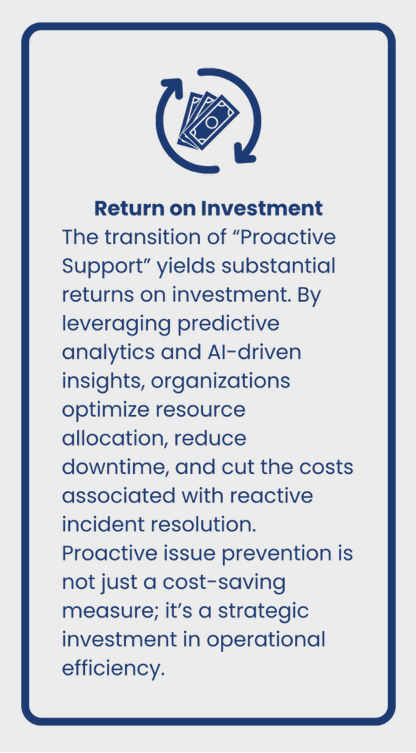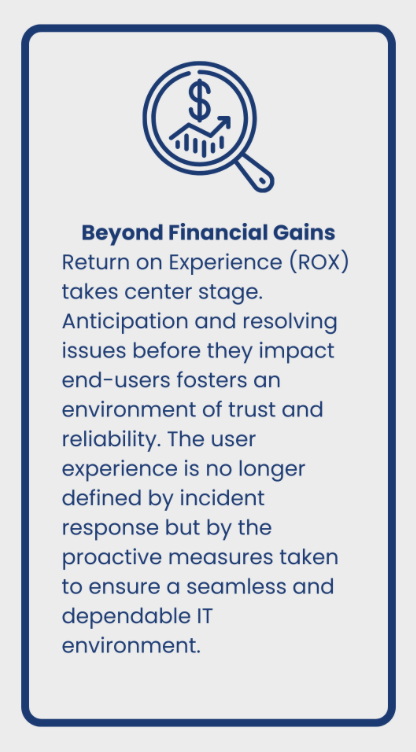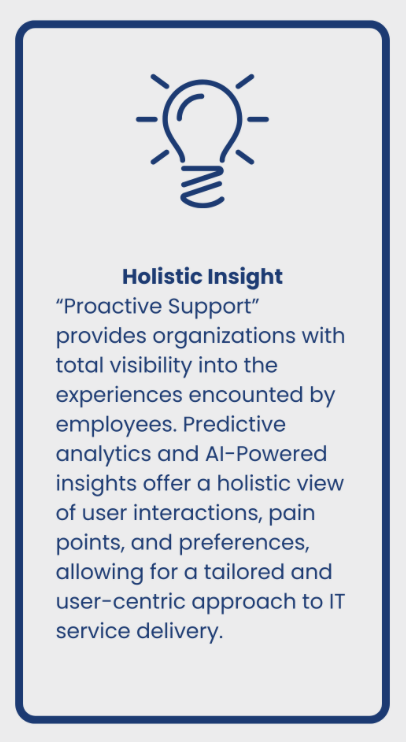MakNuAx is an SBA-approved joint venture between SBA mentor-protégé firms NuAxis and Makpar. We work together to offer Federal agencies full-spectrum services for IT modernization. Our work is proven with award-winning experience and a strong partnership built on integrity and trust. MakNuax is an 8(a)/WOSB/EDWOSB certified company.
Empowering Organizations with Predictive Analytics, AI, and Advanced Automation
In the ever-evolving landscape of IT service management, the conversation needs to extend beyond the concept of “Shift Left.” While the principle of empowering end-users with greater self-service capabilities has been instrumental, the strategic imperative now is to transcend these boundaries.
In this article, the team at MakNuAx explores the compelling need to move towards “Proactive Support” as the catalyst for achieving a profound Return on Investment (ROI) and, more critically, a transformative Return on Experience (ROX). By delving into the realms of predictive analytics, AI-driven insights, and advanced automation, organizations can not only optimize their support functions but also instill heightened trust in their IT services among end-users. This strategic shift embodies a journey that promises to reshape the very fabric of IT support, ushering in a new era of operational efficiency and user satisfaction.
Predictive Analytics and AI-powered Insights
The infusion of Predictive Analytics and AI-powered Insights, coupled with the capabilities derived from Digital Employee Experience (DEX) tools, marks a revolutionary paradigm shift at the service desk. Predictive Analytics, fueled by the historical data insights, enables the service desk to proactively identify and address potential issues before they escalate, offering not just issue prevention but strategic planning and continual improvement. Concurrently, AI-powered Insights, enhanced by the capabilities of DEX tools, introduce a level of intelligence that extends beyond traditional analytics. This amalgamation allows for real-time analysis of user behaviors, system performances, and intricate patterns, providing a comprehensive understanding of the end-user environment. DEX tools, with their ability to monitor user experiences in granular detail, further enrich Predictive Analytics and AI-driven capabilities. This dynamic synergy not only streamlines operational efficiency through automated tasks but also elevates the user experience by anticipating and addressing issues before users are impacted. The result is a service desk that transcends reactive approaches, becoming a proactive, user-centric partner aligned with organizational objectives. This holistic integration ensures a seamless and mission-aligned digital experience for end-users.

Proactive Monitoring and Alerting
Proactive Monitoring and Alerting stand as linchpins in the evolution of the service desk, providing a transformative approach to IT support. By implementing Proactive Monitoring, the service desk gains real-time visibility into the health and performance of IT systems, allowing for the early detection of potential issues. This foresight enables the service desk to address challenges before they impact end-users, reducing downtime and preventing disruptions. The strategic deployment of Alerting systems complements Proactive Monitoring by notifying IT teams of potential issues swiftly, enabling rapid response and resolution. The value of this proactive approach is significantly amplified when utilizing Digital Employee Experience (DEX) tools. DEX tools offer an unparalleled level of granularity in monitoring end-user interactions and experiences. By integrating these tools with Proactive Monitoring and Alerting, the service desk not only detects technical issues but also gains insights into how these issues impact the user experience. This holistic approach not only enhances issue resolution but ensures that the service desk is aligned with the evolving needs and expectations of end-users, ultimately fostering a more responsive, user-centric IT support ecosystem.

The integration of self-healing tools at the service desk represents a revolutionary leap in IT support capabilities. Self-healing tools empower organizations to automate the resolution of routine issues without direct human intervention, ensuring a swift and seamless user experience. By leveraging automation scripts and intelligent algorithms, these tools can identify and rectify common problems, reducing downtime and enhancing operational efficiency. The value of self-healing tools is exponentially heightened when coupled with Digital Employee Experience (DEX) tools. DEX tools provide an in-depth understanding of end-user environments, monitoring user interactions, and experiences in real-time. This integration allows self-healing tools not only to address technical glitches but also to adapt their responses based on the specific needs and behaviors of individual users. The result is a service desk that not only proactively resolves technical issues but does so with a keen awareness of the user experience landscape. This strategic alignment ensures not just efficient issue resolution but a more personalized and user-centric approach, enhancing overall satisfaction and productivity for end-users.
Automation of Routine Tasks
Automation emerges as a cornerstone in revolutionizing Service Desk support, particularly in the realm of routine tasks, leading to heightened operational efficiency and an enriched customer experience. By automating repetitive and predictable tasks, the Service Desk not only accelerates response times but also allows human agents to focus on more complex issues that demand nuanced problem-solving. The strategic integration of Digital Employee Experience (DEX) tools with organizational ticketing systems further enhances this value proposition. DEX tools, with their capacity to monitor end-user interactions and experiences in real-time, become invaluable in deflecting agent calls. Through intelligent automation, routine queries can be swiftly addressed, and consistent responses can be provided across the board. This not only ensures a standardized and seamless customer experience but also empowers users with immediate, accurate, and reliable support. The fusion of automation and DEX tools establishes a symbiotic relationship that not only streamlines service desk operations but fundamentally transforms the customer experience by providing swift, consistent, and efficient support.
Proactive Communication / User Experience Monitoring
Proactive communication, coupled with User Experience Monitoring and the implementation of Experience Level Agreements (XLAs), constitutes a strategic trifecta in elevating service delivery and service desk support. Proactive communication involves keeping end-users informed about potential issues, scheduled maintenance, or system changes before they occur. This transparency fosters a sense of trust and empowerment among users, setting the stage for a positive experience. User Experience Monitoring takes this a step further, providing real-time insights into how end-users interact with IT services. By understanding the nuances of user experiences, the service desk can proactively identify pain points, address issues swiftly, and continuously refine support strategies. The introduction of Experience Level Agreements (XLAs) establishes measurable benchmarks for user satisfaction, responsiveness, and issue resolution. These agreements go beyond traditional Service Level Agreements (SLAs) by centering on the end-user’s perception of service quality.
Continual improvement is ingrained in this approach, as XLAs provide actionable data to refine service delivery, identify areas for enhancement, and ensure an ongoing commitment to user-centric support. The strategic integration of proactive communication, User Experience Monitoring, and Experience Level Agreements creates a symbiotic relationship that not only resolves issues efficiently but cultivates a service desk that is attuned to the evolving needs and expectations of its users.

Collaboration with IT Operations
The collaboration between the Service Desk and IT Operations stands as a linchpin in fostering a holistic approach to IT service management. By sharing insights derived from integrated Digital Employee Experience (DEX) tools and customer feedback, this collaborative synergy transcends silos, providing a comprehensive understanding of the IT landscape. DEX tools offer real-time insights into end-user interactions and experiences, allowing the Service Desk to proactively identify and address issues. Through the exchange of information with IT Operations, these insights contribute to a collective intelligence that aids in root cause analysis. By delving into the core reasons behind incidents, the Service Desk and IT Operations can collaboratively implement preventative measures, preventing the recurrence of issues. This collaboration not only streamlines issue resolution but also facilitates a proactive approach to IT service management, aligning both teams in the shared goal of delivering a seamless and reliable digital experience for end-users.
Continuous Improvement
Embracing a culture of continuous improvement within the Service Desk is paramount in ensuring that it remains agile, responsive, and aligned with evolving user needs. Regularly reviewing and analyzing incident data, customer feedback, and performance metrics becomes the cornerstone of this cultural ethos. This ongoing scrutiny provides invaluable insights into the efficiency of support operations, user satisfaction levels, and the overall health of IT services. By leveraging these metrics, the Service Desk can pinpoint areas for enhancement and implement targeted updates to tools and capabilities. This iterative process not only fine-tunes the service delivery mechanism but also fosters a proactive mindset within the team. The commitment to continuous improvement becomes a driving force, ensuring that the Service Desk remains at the forefront of technological advancements and best practices, delivering an increasingly optimized and user-centric support experience.
Conclusion – Charting the Proactive Course
In the evolution from “Shift Left” to the advanced realm of “Proactive Support,” organizations are not merely reacting to incidents but are strategically anticipating, mitigating, and optimizing their entire support ecosystem. The initial benefits of “Shift Left” lay a foundation of empowerment and user-centricity, providing end-users with greater control and self-service capabilities. However, the transformative journey towards “Proactive Support” amplifies these advantages and introduces a new era of IT service management.
In essence, the journey from “Shift Left” to “Proactive Support” is a strategic leap that transcends reactive support models. It marks a paradigm shift in how organizations perceive and deliver IT services. By investing in the predictive power of analytics and AI, organizations not only enhance operational efficiency but also cultivate a culture of trust, reliability, and alignment with the broader organizational mission. This evolution positions the service desk as a proactive and indispensable force, reshaping the IT support landscape for the benefit of both the organization and its employees.
Considering the transformative potential of proactive support, it is crucial for organizations, including government entities, to consider the following call to action:
1. Evaluate your journey towards proactive support
While the shift from traditional reactive support to proactive support is not necessarily a linear journey, it is important to assess your organization’s readiness for this transition. The “Shift Left” strategy, which involves moving tasks closer to the customer and resolving issues at the earliest possible stage, can be a valuable steppingstone towards proactive support. However, it is not the only path. Depending on your resources, capabilities, and the complexity of your operations, you may choose to implement proactive support directly. The infusion of predictive analytics and AI-powered insights can revolutionize your service desk, enabling you to proactively identify and address potential issues before they escalate.
2. Assess your readiness to implement proactive support
Proactive support requires a robust IT infrastructure, data analysis capabilities, and a customer-centric culture. It is essential to ensure that your organization has these elements in place before embarking on this journey. The integration of self-healing tools, automation of routine tasks, and proactive communication can significantly enhance your readiness for proactive support.
3. Anticipate and address common challenges
The transition to proactive support can present several challenges, including the need for technological upgrades, staff training, and a shift in organizational culture. It is crucial to anticipate these challenges and develop strategies to address them. Collaboration with IT operations, continuous improvement, and the implementation of Experience Level Agreements (XLAs) can be instrumental in overcoming these challenges.
The journey from “Shift Left” to “Proactive Support” represents a strategic leap that can profoundly enhance operational efficiency and user satisfaction. By embracing this journey, organizations can not only optimize their support functions but also instill heightened trust in their IT services among end-users.
If your organization is considering this critical transition and needs assistance, the team at MakNuAx is here to help. Our outreach program is designed to guide organizations through this transformative process, providing the necessary support and expertise. Let’s start a conversation about how we can assist your organization in successfully navigating this journey toward proactive support!



